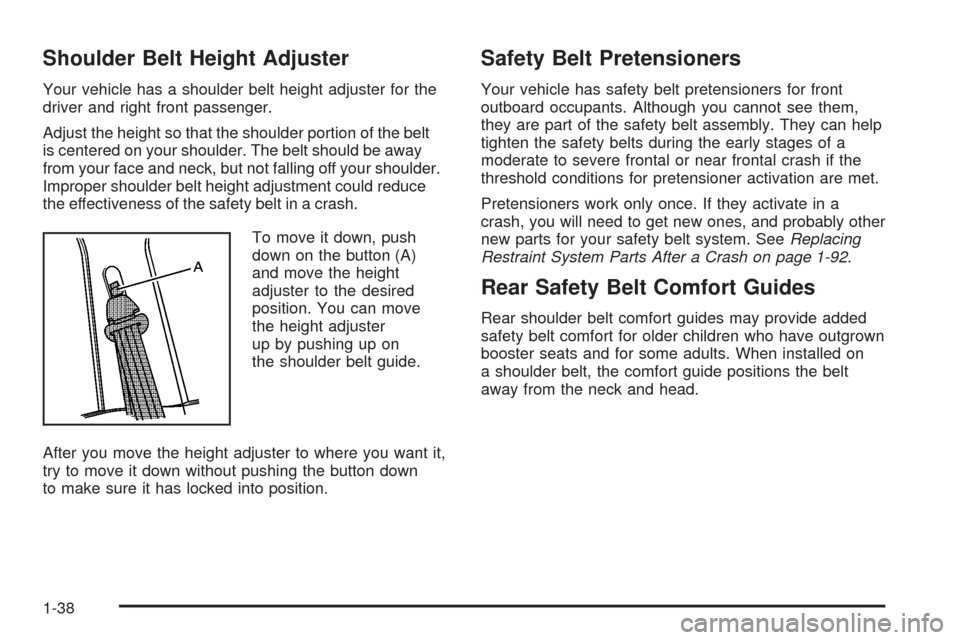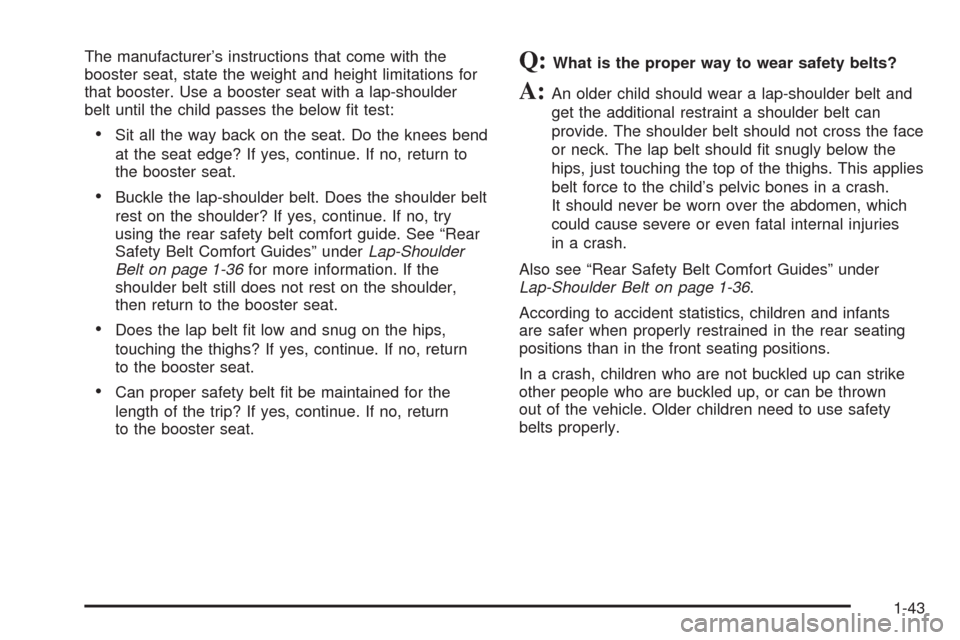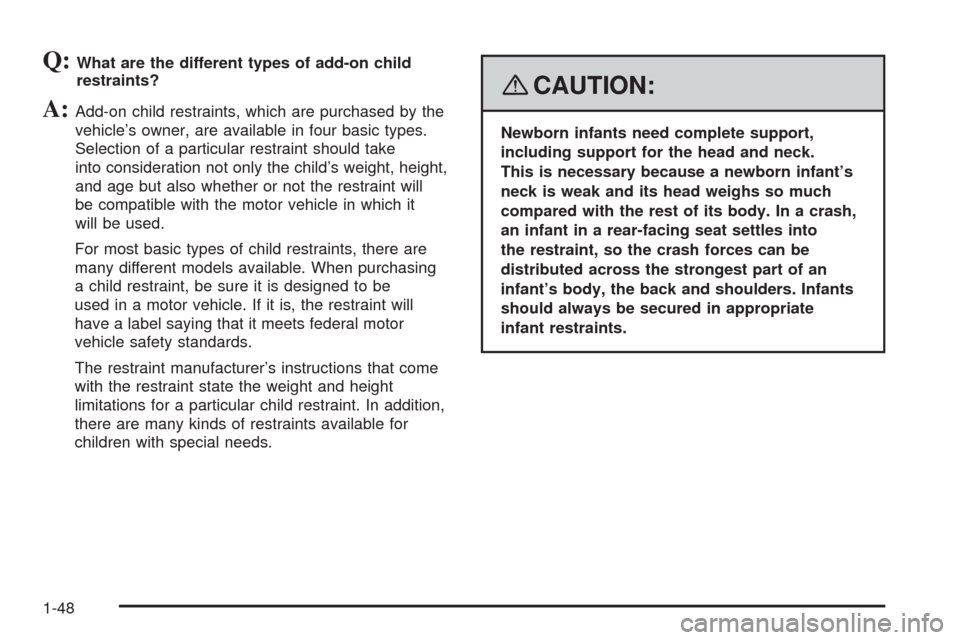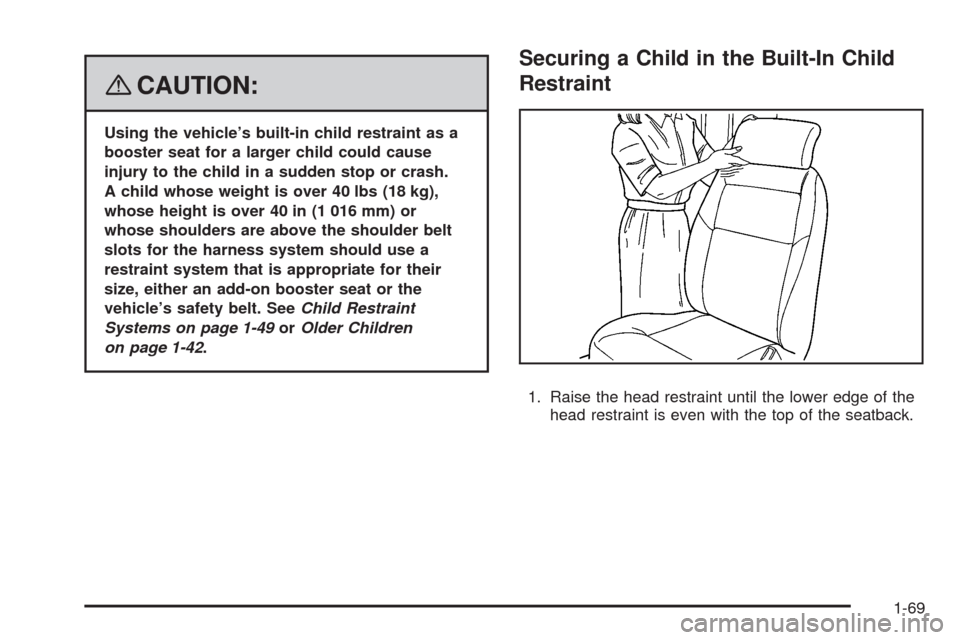2008 CHEVROLET UPLANDER height
[x] Cancel search: heightPage 10 of 476

Head Restraints
Adjust the head restraint so that the top of the restraint
is at the same height as the top of the occupant’s
head. This position reduces the chance of a neck injury
in a crash.
The height of the head restraints can be adjusted on
the �rst and second row seats. Pull the head restraint
up or push it down to adjust it.
The head restraints on the third row seat cannot be
adjusted.
Rear Seats
Rear Seat Operation
The rear seats in your vehicle have levers and straps
used to adjust, remove, and reinstall the seats. By using
the levers and straps in the correct order, you can
easily remove the seats from the vehicle. If your vehicle
has second row captain chairs with airbags, the seats
cannot be removed.
When reinstalling the seats, make sure the seats are in
the proper positions.
If your vehicle has a second row center console, it can
be removed. SeeSecond Row Center Console on
page 2-59. Do not put a seat in the center position
because the safety belt cannot be worn properly in this
position. SeeSafety Belts: They Are for Everyone
on page 1-23.
Bucket Seats
Your vehicle may have bucket seats in the second row.
These seats can be adjusted several different ways.
1-6
Page 40 of 476

Lap-Shoulder Belt
All seating positions in your vehicle have a
lap-shoulder belt.
Here is how to wear a lap-shoulder belt properly.
1. Adjust the seat, if the seat is adjustable, so you can
sit up straight. To see how, see “Seats” in the Index.
2. Pick up the latch plate and pull the belt across you.
Do not let it get twisted.
The lap-shoulder belt may lock if you pull the belt
across you very quickly. If this happens, let the belt
go back slightly to unlock it. Then pull the belt
across you more slowly.
If you ever pull the shoulder portion of a passenger
belt out all the way, you may engage the child
restraint locking feature. If this happens, just let the
belt go back all the way and start again.
Engaging the child restraint locking feature may
affect the passenger sensing system. See
Passenger Sensing System on page 1-85.3. Push the latch plate into the buckle until it clicks.
Pull up on the latch plate to make sure it is secure.
If the belt is not long enough, seeSafety Belt
Extender on page 1-42.
Make sure the release button on the buckle is
positioned so you would be able to unbuckle the
safety belt quickly if necessary.
4. If equipped with a shoulder belt height adjuster,
move it to the height that is right for you. Improper
shoulder belt height adjustment could reduce
the effectiveness of the safety belt in a crash.
See “Shoulder Belt Height Adjustment” later in
this section.
1-36
Page 42 of 476

Shoulder Belt Height Adjuster
Your vehicle has a shoulder belt height adjuster for the
driver and right front passenger.
Adjust the height so that the shoulder portion of the belt
is centered on your shoulder. The belt should be away
from your face and neck, but not falling off your shoulder.
Improper shoulder belt height adjustment could reduce
the effectiveness of the safety belt in a crash.
To move it down, push
down on the button (A)
and move the height
adjuster to the desired
position. You can move
the height adjuster
up by pushing up on
the shoulder belt guide.
After you move the height adjuster to where you want it,
try to move it down without pushing the button down
to make sure it has locked into position.
Safety Belt Pretensioners
Your vehicle has safety belt pretensioners for front
outboard occupants. Although you cannot see them,
they are part of the safety belt assembly. They can help
tighten the safety belts during the early stages of a
moderate to severe frontal or near frontal crash if the
threshold conditions for pretensioner activation are met.
Pretensioners work only once. If they activate in a
crash, you will need to get new ones, and probably other
new parts for your safety belt system. SeeReplacing
Restraint System Parts After a Crash on page 1-92.
Rear Safety Belt Comfort Guides
Rear shoulder belt comfort guides may provide added
safety belt comfort for older children who have outgrown
booster seats and for some adults. When installed on
a shoulder belt, the comfort guide positions the belt
away from the neck and head.
1-38
Page 47 of 476

The manufacturer’s instructions that come with the
booster seat, state the weight and height limitations for
that booster. Use a booster seat with a lap-shoulder
belt until the child passes the below �t test:
Sit all the way back on the seat. Do the knees bend
at the seat edge? If yes, continue. If no, return to
the booster seat.
Buckle the lap-shoulder belt. Does the shoulder belt
rest on the shoulder? If yes, continue. If no, try
using the rear safety belt comfort guide. See “Rear
Safety Belt Comfort Guides” underLap-Shoulder
Belt on page 1-36for more information. If the
shoulder belt still does not rest on the shoulder,
then return to the booster seat.
Does the lap belt �t low and snug on the hips,
touching the thighs? If yes, continue. If no, return
to the booster seat.
Can proper safety belt �t be maintained for the
length of the trip? If yes, continue. If no, return
to the booster seat.
Q:What is the proper way to wear safety belts?
A:An older child should wear a lap-shoulder belt and
get the additional restraint a shoulder belt can
provide. The shoulder belt should not cross the face
or neck. The lap belt should �t snugly below the
hips, just touching the top of the thighs. This applies
belt force to the child’s pelvic bones in a crash.
It should never be worn over the abdomen, which
could cause severe or even fatal internal injuries
in a crash.
Also see “Rear Safety Belt Comfort Guides” under
Lap-Shoulder Belt on page 1-36.
According to accident statistics, children and infants
are safer when properly restrained in the rear seating
positions than in the front seating positions.
In a crash, children who are not buckled up can strike
other people who are buckled up, or can be thrown
out of the vehicle. Older children need to use safety
belts properly.
1-43
Page 52 of 476

Q:What are the different types of add-on child
restraints?
A:Add-on child restraints, which are purchased by the
vehicle’s owner, are available in four basic types.
Selection of a particular restraint should take
into consideration not only the child’s weight, height,
and age but also whether or not the restraint will
be compatible with the motor vehicle in which it
will be used.
For most basic types of child restraints, there are
many different models available. When purchasing
a child restraint, be sure it is designed to be
used in a motor vehicle. If it is, the restraint will
have a label saying that it meets federal motor
vehicle safety standards.
The restraint manufacturer’s instructions that come
with the restraint state the weight and height
limitations for a particular child restraint. In addition,
there are many kinds of restraints available for
children with special needs.
{CAUTION:
Newborn infants need complete support,
including support for the head and neck.
This is necessary because a newborn infant’s
neck is weak and its head weighs so much
compared with the rest of its body. In a crash,
an infant in a rear-facing seat settles into
the restraint, so the crash forces can be
distributed across the strongest part of an
infant’s body, the back and shoulders. Infants
should always be secured in appropriate
infant restraints.
1-48
Page 72 of 476

Built-In Child Restraint
WARNING! DEATH or SERIOUS INJURY
can occur:
Follow all instruction on the child restraint and in
the vehicle’s owner’s manual.
If your vehicle has this feature, the built-in child
restraint is located in the passenger-side position
in the second row.
This child restraint system conforms to all applicable
Federal Motor Vehicle Safety Standards.
Use only with children who weigh between 22 and
40 lbs (10 and 18 kg) and whose height is between
33.5 and 40 in (850 and 1 016 mm). Use only with
children whose shoulders are below the shoulder
belt slots for the harness system and who are
capable of sitting upright alone.
The child should also be at least one year old. It is
important to use a rear-facing infant restraint until the
child is at least one year old. A rear-facing restraint gives
the infant’s head, neck and body the support they
would need in a crash. SeeOlder Children on page 1-42
orInfants and Young Children on page 1-46.
A child whose weight is over 40 lbs (18 kg), whose
height is over 40 in (1 016 mm) or whose shoulders are
above the shoulder belt slots for the harness system,
should be restrained in an add-on booster seat
appropriate for the child’s size. SeeChild Restraint
Systems on page 1-49. Once the booster seat is
outgrown, the child should sit on the vehicle’s regular
seat and use the vehicle’s safety belts.
1-68
Page 73 of 476

{CAUTION:
Using the vehicle’s built-in child restraint as a
booster seat for a larger child could cause
injury to the child in a sudden stop or crash.
A child whose weight is over 40 lbs (18 kg),
whose height is over 40 in (1 016 mm) or
whose shoulders are above the shoulder belt
slots for the harness system should use a
restraint system that is appropriate for their
size, either an add-on booster seat or the
vehicle’s safety belt. SeeChild Restraint
Systems on page 1-49orOlder Children
on page 1-42.
Securing a Child in the Built-In Child
Restraint
1. Raise the head restraint until the lower edge of the
head restraint is even with the top of the seatback.
1-69
Page 94 of 476

Servicing Your Airbag-Equipped
Vehicle
Airbags affect how your vehicle should be serviced.
There are parts of the airbag system in several places
around your vehicle. Your dealer/retailer and the service
manual have information about servicing your vehicle and
the airbag system. To purchase a service manual, see
Service Publications Ordering Information on page 7-15.
{CAUTION:
For up to 10 seconds after the ignition is
turned off and the battery is disconnected,
an airbag can still in�ate during improper
service. You can be injured if you are close
to an airbag when it in�ates. Avoid yellow
connectors. They are probably part of the
airbag system. Be sure to follow proper
service procedures, and make sure the person
performing work for you is quali�ed to do so.
Adding Equipment to Your
Airbag-Equipped Vehicle
Q:Is there anything I might add to or change
about the vehicle that could keep the airbags
from working properly?
A:Yes. If you add things that change your vehicle’s
frame, bumper system, height, front end or side
sheet metal, they may keep the airbag system from
working properly. Changing or moving any parts
of the front seats, safety belts, the airbag sensing
and diagnostic module, steering wheel, instrument
panel, front sensors, or airbag wiring can affect
the operation of the airbag system.
In addition, your vehicle has a passenger sensing
system for the right front passenger’s position,
which includes sensors that are part of the
passenger’s seat. The passenger sensing system
may not operate properly if the original seat
trim is replaced with non-GM covers, upholstery
or trim, or with GM covers, upholstery or trim
designed for a different vehicle. Any object,
such as an aftermarket seat heater or a comfort
enhancing pad or device, installed under or on
top of the seat fabric, could also interfere with
the operation of the passenger sensing system.
1-90